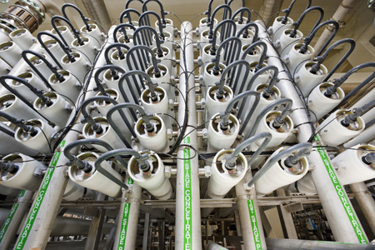The Role Of Reverse Osmosis (RO) Membranes In The Battle Against PFAS

As the global concern over per- and polyfluoroalkyl substances (PFAS) contamination continues to escalate, innovative solutions are becoming increasingly pivotal in the pursuit of clean and safe water resources. The City of Rome Water and Sewer Division conducted a comprehensive pilot to identify a treatment process for removing PFAS from the water supply, including high recovery reverse osmosis technologies.
PFAS have emerged as one of the most formidable environmental challenges of the modern era, primarily due to their persistent and pervasive nature. These synthetic chemicals, commonly found in a wide array of industrial and consumer products, possess unique properties that make them resistant to heat, water, and oil. While this durability has contributed to their extensive use in various applications, it has also led to their widespread distribution in the environment, causing significant concern among scientists, environmentalists, and public health officials.
One of the defining characteristics of PFAS is their resistance to degradation, earning them the label of "forever chemicals". This persistence in the environment has led to their accumulation in soil, water, and air, presenting a long-term and challenging threat to ecosystems and human health. The bio-accumulative nature of PFAS compounds, coupled with their ability to travel long distances through water and air, has led to their ubiquitous presence in the environment, even in remote and seemingly untouched areas. This global dispersion has magnified their environmental impact, making them a complex and pervasive concern for communities worldwide.
The adverse health effects associated with PFAS exposure have raised alarm bells among health professionals and policymakers. Studies have linked these chemicals to a range of health issues, including developmental effects, immune system disruption and an increased risk of certain cancers. These combined factors underscore the urgency of addressing the widespread presence of PFAS and implementing robust strategies to mitigate their impact on the environment and public health.
Regulatory Updates In The U.S.
Under the Biden-Harris Administration, the Environmental Protection Agency (EPA) has undertaken a series of significant regulatory measures to address the pressing issue of PFAS contamination in the United States.

However, there remains concern that current regulations only focus on specific PFAS chemicals and fail to address the broader issue comprehensively.
"There are regulations coming out that are for particular PFAS chemicals,” says Bruce Alderman, CEO of ROTEC USA. "However, PFAS is a whole group of chemicals, around 5,000 different types, only regulating a couple isn’t going to solve the issue.”
Navigating through these complexities, including the dual challenge of managing present problems and preparing for upcoming regulations, presents one of the most daunting obstacles for utilities.
The Role Of Water Utilities
Water utilities play a pivotal role in combating PFAS contamination. They have a responsibility, striving to act as responsible custodians for their ratepayers and communities. Yet, they are confronted with a daunting challenge in identifying and managing emerging contaminants, often necessitating tests at extraordinary levels, down to the parts per trillion.
The struggle to keep up with evolving water quality standards is further amplified by the need for cutting-edge technologies and expertise. Municipal utilities require substantial support from state and federal governments to address the intricate challenges posed by PFAS and other contaminants.
Industry analysts, Bluefield Research’s recent PFAS remediation forecast, predicts that drinking water utilities will spend nearly $13.5 billion from 2023 to 2030 — a substantial increase previous estimates of $6 billion.
Furthermore, the U.S. federal government’s Infrastructure Investment and Jobs Act has allocated $9 billion to address PFAS in drinking water systems, with a further $1 billion allocated for addressing PFAS in wastewater streams between 2022-2026.
A Notable Pilot Project: The City of Rome, Georgia
In light of the regulatory movement and pressing environmental challenge, multiple pilot projects have been taking place across the U.S. market. One notable example is the City of Rome Water and Sewer Division comprehensive pilot study at the Bruce Hamler Water Treatment Facility in Rome, Georgia. This aimed to identify the most effective and sustainable treatment process for removing PFAS from the water supply.
Six treatment process trains were tested, demonstrating significant PFAS removal but falling short of completely eliminating all compounds to non-detectable levels as initially targeted. Notably, reverse osmosis (RO) technologies exhibited the highest and most consistent PFAS removal rates.
Considering various factors, including PFAS removal efficiencies, capital and operational costs, pilot equipment performance, and feedback from Rome WSD staff, it was recommended replacing the existing treatment trains at the Hamler WTF with disk filter pretreatment followed by either closed circuit RO or cross flow reverse osmosis operating at a minimum 90% recovery rate.
Data on anticipated lifecycle costs further underscored the viability of the RO approach, with the flow reversal reverse osmosis (FR-RO), closed circuit reverse osmosis, and cross flow reverse osmosis technologies presenting estimated 20-year lifecycle costs of $142 million, $161 million, and $163 million, respectively.
The Role RO Membranes Can Play In Treatment Solutions
The focus on RO and nanofiltration membranes presents a promising avenue for addressing not just PFAS contamination but also dozens of other emerging contaminants.
"RO can separate nearly all of the different emerging contaminants to some level, thus providing a permeate water that is suitable for drinking for almost all of those categories," Alderman explains.
However, a key challenge arises from the concentration of the contaminants during the RO process, which requires efficient handling of the resulting concentrate. Typically, an RO system discards around 25% of water, intensifying the concentration of contaminants by a factor of four.
Alderman emphasizes ROTEC's advantageous approach, as it returns 90% of the water, resulting in significantly less waste compared to traditional RO systems. "You're making a smaller quantity of brine that you have to deal with for any subsequent destruction technology," he notes.
Furthermore, he highlights the cost-effectiveness of ROTEC's high recovery RO solution over the long term, particularly in comparison to alternative treatments such as granular activated carbon (GAC). By employing RO as a preliminary step to remove various PFAS chains before applying GAC, the necessary carbon plant footprint could be reduced significantly, resulting in more efficient long-term operations and reduced lifecycle costs. He also emphasizes that RO has the potential to address emerging contaminants beyond PFAS, such as 1,4-dioxane and other substances.
"By combining RO with carbon filtration, you not only ensure clean water but also have the option to reuse the wastewater, creating an efficient and reliable solution that offers the best of both worlds," Alderman concludes.
Dr. Graeme Pearce, principal at Membrane Consultancy Associates, specializes in advice on membrane filtration technology. He says the process needs to involve both PFAS removal and destruction.
“The PFAS challenge is two-fold,” he adds. “Firstly, the compounds need to be removed from the treated water to a level acceptable for human consumption. Secondly, they need to be destroyed to prevent a waste discharge which allows them to build up in the environment. A technology such as RO is well proven to meet the removal goals.
The key to this approach is providing the benefit of reducing the volume of the waste stream requiring destruction of the concentrated PFAS. The cost of destruction technologies is often more influenced by the volume to be treated than by the concentration. An RO operating with 90% recovery could therefore achieve a very significant cost reduction since only one-tenth of the flow would have to be treated.”
Dr. Pearce believes a combined approach will be necessary to address the PFAS challenge. “The combined approach of RO plus destruction technology for the concentrate provides a degree of security that potentially mirrors the multi-stage/multiple barrier approach often adopted for advanced treatment in wastewater reuse,” he adds.
“The de-linking of functions provides a failsafe method to address the PFAS problem. It will take individual site-specific cost assessments to confirm whether the approach makes economic sense, but it appears to offer promise and would certainly provide a robust solution.”
The Need For A “Tech Stack” Of Solutions And Partnerships
Integrating diverse technological solutions and partnerships is a critical strategy in tackling PFAS.
Continuing this theme, Alderman emphasizes the significance of incorporating various technologies into a comprehensive "tech stack" when addressing PFAS contamination. He underscores the unparalleled quality of water produced through high recovery RO systems, highlighting its capacity to deliver the highest quality drinking water currently achievable.
However, he also acknowledges the issue of concentrated wastewater generated through the RO process and the necessity of dealing with it effectively. ROTEC, with its ability to significantly minimize wastewater, 25% of that produced by traditional RO systems, plays a pivotal role in this combined approach.
Moreover, Alderman emphasizes the need to explore additional advanced technologies like foam fractionation, which serves as a concentration tool to reduce wastewater to a manageable scale for subsequent treatment. "By harnessing the strengths of each technology and effectively addressing their respective limitations, a holistic solution that targets the PFAS problem at its core can be developed," he notes.
Collaboration Is Key
Collaborative efforts are underway within the industry. ROTEC has formed a number of ultrafiltration and carbon partnerships, integrating the organization’s toolbox alongside RO technology. These collaborations leverage the use of activated carbon with membranes, offering an effective solution for extracting a wide range of contaminants, including PFAS. When faced with the need to extract a broader spectrum of pollutants, the integration of RO technology becomes indispensable, he claims.
“With our solution we want to help support the municipalities, utilities themselves, through working with their engineering firms and people that are helping provide them guidance. We can do some of that initial pilot work and testing, but in the end, we are happy cooperating with some of the other larger water companies for the final solution. Our intent is to collaborate and provide combined solutions,” Alderman concludes.
The multifaceted nature of the PFAS crisis demands a comprehensive approach that integrates advanced technologies and collaborative partnerships. By leveraging the strengths of various technologies, including RO membranes, foam fractionation and activated carbon, water utilities can effectively manage concentrated wastewater while ensuring the production of clean, high-quality drinking water.
As industry collaborations continue to evolve, leading water companies will have no choice but to join forces, underscored by a shared commitment to developing holistic solutions that safeguard water resources and public health.
